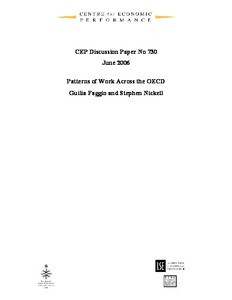Patterns of work across the OECD
"Market work per person of working age differs widely across the OECD countries and there have been some significant changes in the last forty years. How to explain this pattern? Taxes are part of the story but much remains to be explained. If we include all the elements of the social security...
| Main Authors: | , |
|---|---|
| Institution: | ETUI-European Trade Union Institute |
| Format: | TEXT |
| Language: | English |
| Published: |
London
2006
LSE |
| Subjects: | |
| Online Access: | https://www.labourline.org/KENTIKA-19293068124910112409-Patterns-of-work-across-the-oe.htm |
| Summary: | "Market work per person of working age differs widely across the OECD countries and there have been some significant changes in the last forty years. How to explain this pattern? Taxes are part of the story but much remains to be explained. If we include all the elements of the social security systems like early retirement benefits, sickness and disability benefits and unemployment benefits, then we can capture some aspects of the overall pattern but still a lot remains unexplained. The story favoured by Alesina et al. (CEPR DP.5140, 2005) is that the nexus of strong unions, generous welfare and social democracy implies both high taxes and pressure in favour of work-sharing in response to adverse shocks. This story, however, falls foul of the simple fact that most Scandinavian countries now do much more work than the French and Germans despite having stronger unions, more generous welfare, higher taxes and more social democracy. Ultimately, we are forced into the position that there is no simple story. Some of the broad patterns can be explained but there remain country specific factors which are hard to identify but lead to substantial differences from one country to another. " |
|---|---|
| Physical Description: | 41 p. Digital |

